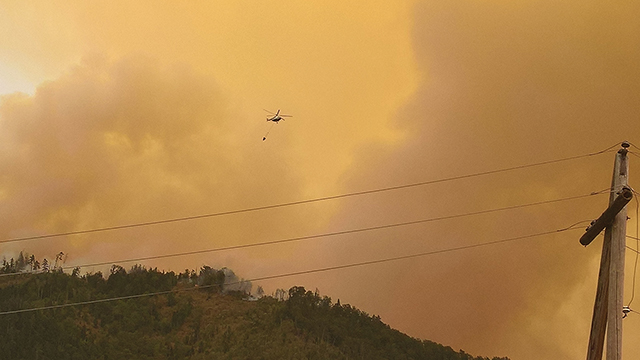The Russian invasion of Ukraine and the global pandemic have diverted attention from climate change and green economy.
The process of climate change is not halted because of geopolitical shifts, but it remains just as relevant as it was before the war. The war has also had a devastating impact on the environment: wildlife has been destroyed and craters have appeared over the terrain. Explosive releases of toxic chemicals and heavy metals have spread across the landscape. The destruction of oil and natural gas facilities, as well as the launch of missiles, has caused forest fires and released radioactive material in the air. According to the United Nations the pollution caused by the missiles has created an “ecological disaster,” with over 530,000 hectares (McCarthy 2022) of protected land “affected or destroyed”.
This blog will discuss the correlation between human negligence and summer forest fires, climate change, and the effects of global warming. Since the so-called “fire season” (July to August) is fast approaching, it would be interesting for our readers if they could understand how these threats can either be avoided or minimized.
The first version was developed as part of the “Training for Journalists on the Green Economy Project” of ISET. A journalist from Borjomi TV spoke about the topic, using the Samtskhe – Javakheti region as an example and the Borjomi Municipality. ISET Policy Institute has re-launched this blog in order to emphasize the relevance of this topic.
INTERLINKAGES ARE ESTABLISHED BETWEEN FORESTRY AND CLIMATE CHAIN
The links between climate change and forestry are numerous, multidirectional, and therefore complex.
As we have discussed in previous blogs, fires are on the rise around the globe. They are primarily associated with climate changes, but improper clearing and maintenance can also be a factor.
Climate change can increase the risk of fires in many ways.
a) Due to global warming, the summer and fall months are hotter. This leads to longer fire seasons.
b) High temperatures lead to drier conditions, which promote evaporation and reduce soil saturation with water. These conditions not only increase the risk of fires but also make it harder to fight them as they spread more quickly.
c) The longer and drier seasons create conditions that are more favorable for pests, who can tolerate winter better and reproduce faster. These pests can kill trees because they dry out the wood and make it more susceptible to decay. This creates a perfect environment for forest fires.
Lightning during thunderstorms is one of the main causes for forest fires, and this is often due to climate changes.
Georgia is not an exception to this trend. As a result of climate changes, fires are now occurring in places where they were never seen before. The relationship between climate change, forest fires and drought is not one-sided. Forest fires release large amounts of greenhouse gases, which can lead to climate change and increased drought risk. Forests are the primary terrestrial carbon sink eco-systems. They play a significant role in climate change and its negative impacts. Forest fires not only pollute, but also accelerate climate change.
The Forestry Sector in Georgia and Climate Change: The SAMTSKHE-JAVAKHETI and BORJOMI Fires
Forests cover about 40% of Georgia’s total land area. Forests are also crucial to the country’s balance of greenhouse gases. In recent years, the development of the socio-economic environment has had a negative impact on the forests. It has led to deforestation, fires and a significant decrease in their carbon absorption capacity. In Samtskhe Javakheti in areas managed by the National Forest Agency (NFA), 34 fires were reported in the past 15 years. NFA data for 2021 shows these fires covered an area of 2425.83 hectares, which is 2% of Samtskhe Javakheti’s forest area.
The local population in Borjomi has felt the effects of these fires more and more. The microclimate change is most noticeable in settlements that surround burned forests. According to Vazha Gelashvili a biologist, fires in this region have caused the air to become drier, continental and the number freshwater sources have decreased. Forest fires, more frequent droughts followed quickly by heavy rains, and other climate-related changes in the environment have also reduced the region’s potential for tourism and affected the economy.
The Georgian National Greenhouse Gas Index Report (1990-2017), however, shows that land use and forestry sectors, if managed correctly, remain significant absorbers for greenhouse gases. This makes a significant contribution towards climate change mitigation. The sink capacity for this sector fluctuated from 8,122 to 10,061 gigagrams CO2 eq. Between 1990-2017, this represents 20-65% of the total emissions during that period. Forests absorb a large proportion of emissions. Therefore, forest fires should be given more attention, since they absorb a large portion of emissions.
What is being done to reduce forest fires?
The Government of Georgia has set three priorities to mitigate climate change within the forestry sector (MEPA 2021, p.29):
a) Establishment of sustainable forest management practices
(b) Promotion of natural restoration and implementation of reforestation, forest restoration and reforestation;
(c) The expansion and protection of protected areas.
According to the National Forest Agency (NFA), the country has prepared several documents that address climate change adaptation and mitigation, including those that define the target indicators and actions to be taken throughout the years. Georgia’s Updated Nationally Determined Contributions for the UN Framework Convention on Climate Change, under the Paris Agreement. Georgia’s 2030 Climate Change Strategy.
The Fourth National Communication of Georgia also identifies the fact that climate change is a growing problem and that it is important to take steps to adapt. It also explains what actions the agency has taken. The document also highlights the development and implementation of fire prevention measures.
* The layout of roads and paths to firefighting;
* The clearing of forest;
* The development and implementation of early detection and notification systems.
A methodology for assessing forest fire risks has also been developed. Fire-hazardous zones have been identified, where monitoring is intensified during problematic periods with the help of additional hired firefighters. Sites for lighting bonfires have also been designated, as well as the placement of information panels and boards. In addition, 107 agency staff and 30 volunteers will be trained in forest fire control in all regions in 2021.
What is needed, what do we know, and what can the population do?
Rezo Getiashvili is a representative of CENN, an NGO that works to protect the environment. He explains that responding effectively to climate change can be a complex process that requires many decisions. The world is still struggling to find ways to deal with the effects and challenges that climate change has brought. According to him, during the fire season, additional hazards are needed. For example, the prohibition on bonfires, or even the general ban of movement in forests, as well a arranging tourist and recreational infrastructure within forests. In Georgia, burning waste in agricultural plots can also cause fires. There has been a law in place since 2015 that regulates this issue and includes the relevant sanctions. However, we have yet to enforce it. It is therefore necessary to implement effective enforcement mechanisms.
Another core problem is the lack of information about the negative impacts of climate changes and the role that the populace plays in slowing down the process. A small survey conducted in Borjomi revealed that while some locals believe in climate change, many do not believe it has an impact on their lives today or consider their role significant.
A study conducted in Georgia by the Caucasus Environment Center, commissioned by the European Union (EU) and the United Nations Development Program(UNDP), from August to September 2020, revealed similar attitudes:
* 97.6% have heard of climate change.
* 91,35 % of the population believes that climate change is real and threatens life on Earth.
* 25.9% believe that international organizations can manage the effects of climate changes;
* 36,19% of the population believe they can do nothing about climate change.
Despite the public perception, individuals can take simple steps to slow down climate change, prevent periodic fires and sustain forest management in particular:
* Avoid starting fires artificially;
* Avoid lighting bonfires on wooded areas during the dry summer months.
* Be sure to follow fire safety rules when in the woods.
* Do not burn waste on agricultural land
Reduce the excessive use of firewood
* Clear the area after cutting down trees of any remaining branches.
* Use energy-efficient ovens.
CONCLUSION
Climate change and forest fires are linked. On the one hand, climate change increases the likelihood of forestfires. On the other hand, forest fires accelerate this process. The issue is becoming more urgent worldwide, and Georgia must be involved in the community response.
In order to benefit the population, state policies that are aimed at reducing forest fires and slowing climate change should be accompanied with more awareness and information campaigns. This should not only be done in large cities but also in regions such as Samtskhe and Javakheti, to highlight the links between individual actions on the one hand and the forest fires which have been ravaging these regions recently.
BLOG by Eka Nozadze, Erekle Shubitidze
Read More @ georgiatoday.ge












